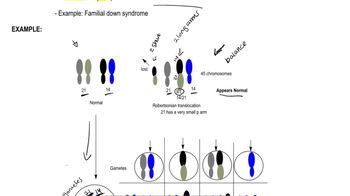A healthy couple with a history of three previous spontaneous abortions has just had a child with cri-du-chat syndrome, a disorder caused by a terminal deletion of chromosome 5. Their physician orders karyotype analysis of both parents and of the child. The karyotype results for chromosomes 5 and 12 are shown here. What segregation pattern occurred to produce the gamete involved in fertilization of the child with cri-du-chat syndrome?
Table of contents
- 1. Introduction to Genetics51m
- 2. Mendel's Laws of Inheritance3h 37m
- 3. Extensions to Mendelian Inheritance2h 41m
- 4. Genetic Mapping and Linkage2h 28m
- 5. Genetics of Bacteria and Viruses1h 21m
- 6. Chromosomal Variation1h 48m
- 7. DNA and Chromosome Structure56m
- 8. DNA Replication1h 10m
- 9. Mitosis and Meiosis1h 34m
- 10. Transcription1h 0m
- 11. Translation58m
- 12. Gene Regulation in Prokaryotes1h 19m
- 13. Gene Regulation in Eukaryotes44m
- 14. Genetic Control of Development44m
- 15. Genomes and Genomics1h 50m
- 16. Transposable Elements47m
- 17. Mutation, Repair, and Recombination1h 6m
- 18. Molecular Genetic Tools19m
- 19. Cancer Genetics29m
- 20. Quantitative Genetics1h 26m
- 21. Population Genetics50m
- 22. Evolutionary Genetics29m
6. Chromosomal Variation
Chromosomal Rearrangements: Deletions
Problem 32a
Textbook Question
A healthy couple with a history of three previous spontaneous abortions has just had a child with cri-du-chat syndrome, a disorder caused by a terminal deletion of chromosome 5. Their physician orders karyotype analysis of both parents and of the child. The karyotype results for chromosomes 5 and 12 are shown here. Are the chromosomes in the child consistent with those expected in a case of cri-du-chat syndrome? Explain your reasoning.
 Verified step by step guidance
Verified step by step guidance1
Review the karyotype results for the child to identify any abnormalities in chromosome 5. Cri-du-chat syndrome is caused by a terminal deletion on the short arm of chromosome 5 (5p). Look for evidence of this deletion in the child's karyotype.
Compare the child's karyotype with the karyotypes of the parents. Determine if either parent carries a structural rearrangement, such as a balanced translocation, that could have contributed to the deletion in the child.
If a balanced translocation is present in one of the parents, analyze how this could lead to an unbalanced karyotype in the child. Specifically, consider how the segregation of chromosomes during meiosis could result in the loss of genetic material on chromosome 5.
Evaluate whether the observed deletion in the child's chromosome 5 matches the expected characteristics of cri-du-chat syndrome. This includes confirming that the deletion is terminal and affects the short arm (5p).
Conclude whether the child's karyotype is consistent with cri-du-chat syndrome based on the presence of the terminal deletion on chromosome 5 and the inheritance pattern observed in the family. Provide reasoning that ties the karyotype findings to the clinical diagnosis.
 Verified video answer for a similar problem:
Verified video answer for a similar problem:This video solution was recommended by our tutors as helpful for the problem above
Video duration:
1mPlay a video:
Was this helpful?
Key Concepts
Here are the essential concepts you must grasp in order to answer the question correctly.
Cri-du-chat Syndrome
Cri-du-chat syndrome is a genetic disorder caused by a deletion of a portion of chromosome 5, specifically at the 5p15.2 locus. This condition is characterized by distinctive features such as a high-pitched cry resembling that of a cat, developmental delays, and various physical abnormalities. Understanding the genetic basis of this syndrome is crucial for analyzing the karyotype results and determining if the child's chromosomes align with the expected genetic profile.
Recommended video:
Guided course

Robertsonian Translocations
Karyotype Analysis
Karyotype analysis is a laboratory technique used to visualize an individual's chromosomes, allowing for the assessment of chromosomal number and structure. This analysis can identify chromosomal abnormalities, such as deletions, duplications, or translocations, which are critical in diagnosing genetic disorders. In the context of cri-du-chat syndrome, examining the karyotype of the child will reveal whether the deletion on chromosome 5 is present, confirming the diagnosis.
Recommended video:
Guided course

Chi Square Analysis
Chromosomal Deletion
A chromosomal deletion refers to the loss of a segment of DNA from a chromosome, which can lead to the loss of genetic material and associated functions. In cri-du-chat syndrome, the deletion on chromosome 5 results in the absence of crucial genes that are necessary for normal development. Understanding the implications of such deletions is essential for interpreting karyotype results and assessing the genetic health of the child.
Recommended video:
Guided course

Deletions
Related Videos
Related Practice
Textbook Question
318
views


